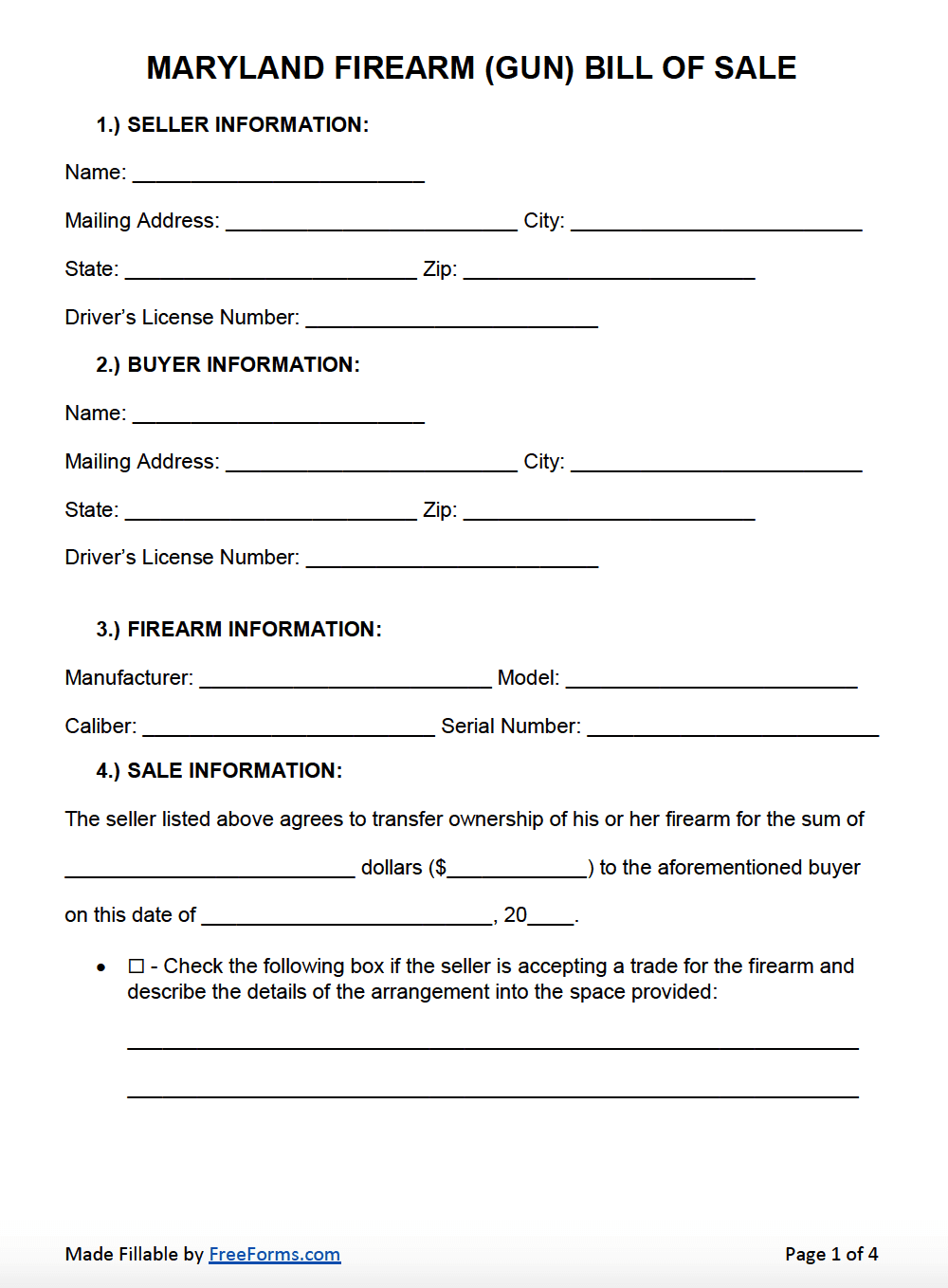The Maryland firearm (gun) bill of sale form enacts a detailed filing of the pertinent information involved in the sale of a firearm. This contract creates evidence of the transfer of ownership once it is endorsed and notarized. Recorded in the document is the data related to the buyer, seller, firearms, and specific terms of the purchase.
How to Register a Gun
There are many laws restricting the purchasing, storing, carrying, and transporting of a firearm in the state of Maryland. According to the Maryland Public Safety Code § 5-117.1, the legislation stipulates that any individual that would like to purchase, rent, or transfer a handgun must apply and be granted a Handgun Qualification License to do so. This same obligation is not necessary to buy a rifle or shotgun. To obtain a Handgun Qualification License, you may apply online at the Maryland State Police Licensing Portal. Keep in mind, you will be required to submit a fingerprint card (from a participating provider), and additionally, undergo a background check and state-approved firearms safety program. When purchasing through a federally licensed firearm dealer or private sale, the buyer will need to pass a background check (even upon receiving a valid HQL), and the transaction will be recorded and sent to the state authorities to archive the transfer. Many guns categorized as “automatic weapons” are mandated to be registered, but you may also voluntarily register a gun that does not necessarily require registration on the licensing portal as well, should you choose to.
How to Obtain a Conceal and Carry Permit
Long guns can be carried openly without a secured permit, but only in areas deemed acceptable by the state laws (for hunting, shooting competitions, or shooting ranges). To carry a handgun openly will require licensure and is only granted to security officers that meet the standard criteria. Alternatively, to carry a concealed handgun will require an individual to gain access to a Maryland Handgun Qualification License.
To apply for the Handgun Qualification License, you will need to fill in a Maryland Handgun Qualification License Application or do so electronically by visiting the online licensing portal. You can then create an account and proceed to fill out the electronic application. Once you have finished, print out the completed form. You can then send via mail to the Maryland State Police Licensing Division, the following documentation:
- Finalized Maryland Handgun Qualification License Application Form.
- Certificate of completion of a firearm training course from a qualified instructor.
- A fingerprint identification card.
- A passport-style color photograph of the applicant, taken within 30 days of submission.
- Payment in the form of a cashier’s check or money order for all application fees ($50).
You can then send the listed materials in a sealed and stamped envelope to the following address:
Maryland State Police
Licensing Division
1111 Reisterstown Road
Pikesville, MD 21208
Once submitted, processing and background checks can take up to 3 months for a response via mail. After receiving a license, the renewal will not be required for another two years in the same month as it was in which it was issued.
How to Write
Step 1 – Download the Adobe PDF form you would like to use.
Step 2 – Seller Information – fill out the pertinent seller information:
- Name
- Mailing Address
- City
- State
- Zip Code
- Driver’s License
Step 3 – Buyer Information – Type in the same information for the individual purchasing the weapon:
- Name
- Mailing Address
- City
- State
- Zip Code
- Driver’s License
Step 4 – Firearm – Complete the prompted request for information regarding the gun being transferred:
- Manufacturer
- Model
- Caliber
- Serial number
Step 5 – Sales Information – Include the information referring to the sale terms as follows:
- Sales Price (numerical and written formats)
- Sales Date
- Detail any specifics should items be involved for trade in the transaction. Include any make, model, serial number information if applicable.
Step 6 – Disclosure Statements – First read the disclosure statement and then only sign once both individuals agree with the statements with an official notary present to witness the signatures.
Step 7 – Signatures – Finalize the document with endorsements agreeing to all contract terms with the help with an authorized notary. The notary can then complete the form with all necessary validating signatures and seals.



0 comments
Comments are closed.